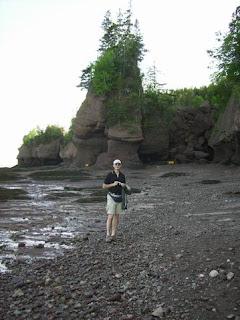
First stop this morning was Fort Anne, just a stone's throw from our B&B. Several years after the failure of the first Port Royal, the French returned to the area and built a fort on this new site naming it Port Royal. The fort was expanded over the years and changed hands a few times until the British finally gained control for good in 1710. It was the capital of the Maritime possessions of the French and then the British until the capital was moved to Halifax in 1749. There were very good interpretive displays explaining the purposes of the various design elements of the fort and the earthworks are still pretty much intact. Another interesting and worthwhile stop.

Next, we went to Port Royal. This was the site of the first French settlement in this area in 1605. Parks Canada reconstructed the settlement in 1939-40 based on drawings by Champlain and historical accounts of the site. It was very well done and very interesting. I remember hearing all these names of people and places from my high school history classes, but how they all relate to each other was kind of murky. This tour is helping to straighten out all these details about the beginning of our country.
Shortly after Port Royal, we made a brief unscheduled stop at the Melanson Settlement which was on the same road. This was another Acadian farming site that was excavated by archaeologists. It was a minimalist site and only took us about ten minutes.

We debated skipping our last planned stop at the North Hill Museum to try to gain some time, but decided to squeeze it in anyway. And we were glad we did. When the interpreter met us, she asked us if we wanted the tour or just to look around. We almost said we would just look around, but we were glad we didn't. The building was among the very oldest houses in the area. It was purchased many years ago by an antique collector who restored the house and filled it with interesting items, leaving it to the province in his will.
From the museum, we went to a German restaurant for lunch. We over did it with schnitzel sandwiches, potato salad, and turnovers for dessert. It was very good, but we sure were full!

We had planned to follow the coast from Annapolis Royal to Yarmouth, then back to the LaHave historic site and overnight in Lunenberg. But we were running so late that we decided to short cut directly overland to Liverpool, just south of our destination, and go on from there. We probably would not have made it before closing at the LaHave site anyway, but a couple of construction delays totaling 45 minutes or more sealed the deal. We decided to stop in Liverpool, checked into our hotel around 5, and went for a long walk around the centre of town and the river. I made a short stop to do a little unpaid construction work.
Today was probably the nicest day yet. It was sunny with a light breeze. It started out cool in the morning but warmed up nicley. By late afternoon, it had clouded over and the wind had come up, but we were in the car and didn't care.

























